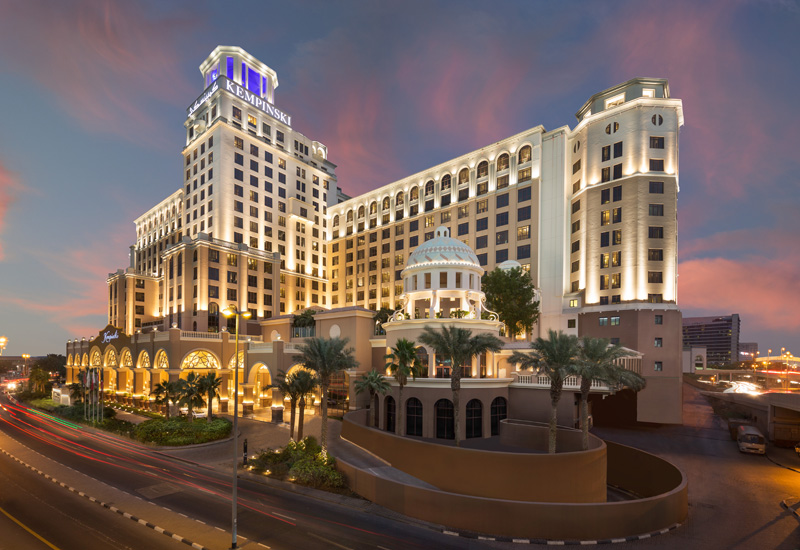 The Kempinski Hotel Mall of the Emirates team had the challenge of carrying out the refurb without disrupting operations
The Kempinski Hotel Mall of the Emirates team had the challenge of carrying out the refurb without disrupting operations
A hotel refurbishment is among the most challenging projects in the commercial construction industry, however it is rare and economically challenging for a hotel to close for renovation. Celebrating its 10th anniversary, Kempinski Hotel Mall of the Emirates, the first property of the hotel chain in Dubai, has just completed an extensive US $100m renovation. The refurbishment began in 2012 and was done in multiple phases, including the complete renovation of the public and dining areas, and all 373 rooms and suites, which followed the upgrading of conference facilities.
Adjacent to the Mall of the Emirates and the Middle East’s only indoor ski slope, the final 20 Aspen Ski Chalets overlooking Ski Dubai are due to re-open this month, marking the completion of the final phase of the programme.
For the interior design of the public spaces and rooms, hotel owner Majid Al Futtaim Group appointed Wimberly Interiors, part of WATG, while Dubai-based Bassos Design did the interiors of both Olea, the all-day dining restaurant and Noir lounge and cocktail bar. Local fit-out contractor ISG Middle East was also hired.
On the outside
ISG Middle East managing director Alan McCready says the Kempinski Hotel Mall of the Emirates was the firm’s flagship hospitality project in the UAE. He says: “Initially, Majid Al Futtaim was looking for a contractor that could perform external refurbishment. We devised an innovative way to conduct these works with absolute minimum impact to hotel guests. It was our innovative action plan that grabbed the client’s attention; we came up with a technical solution that would really work.”
The contractor’s plan for the hotel was as ambitious as it was novel. McCready and his colleagues set about transforming the building’s exterior without the knowledge of either paying customers or the general public.
“We completely refurbished the exterior of the hotel, almost without the knowledge of the wider world,” reveals McCready. “Conventional methods would have required the erection of huge scaffolds along the building’s walls to facilitate work on its profile, façades, and external lights. Instead, we engineered it so that 95% of our activities were conducted through rope access. We succeeded in completing the entire exterior with approximately 30 abseilers. It was like special ops. And it was difficult to see the work taking place; due to the size of the hotel, our construction workers were barely noticeable.”
And perhaps it was the covert nature of ISG Middle East’s work on the exterior of Kempinski MOE that convinced Majid Al Futtaim to enlist McCready and his team for the interior portion of its refurbishment plan.
“The contract relating to the external façade was secured at the end of 2013,” McCready recalls. “We started work in spring 2014, and the interior refurbishment contract was awarded to us in April of that year. We were only given a six-week lead-in time for the interior fit out, and you can imagine what the procurement process was like for a hotel of this size. It was a major endeavour,” McCready says.
To make things even more challenging, ISG Middle East was tasked with fitting out the interior of the hotel whilst its day-to-day operations continued. This required not only stealth, but also an expertly managed handover schedule.
“It’s important to remember that this is a fantastically successful hotel,” notes McCready. “Occupancy rates are right up there; close to 100% for most of the year. We’re talking about significant revenue streams so the owner and operator didn’t want to close their doors. Even so, they demanded the absolute best for their guests; it was vital that the upgrades of the rooms and facilities didn’t interfere with the customer experience.
“With this in mind, we worked with Majid Al Futtaim and Kempinski Hotels to minimise the number of rooms that were out of action at any one time. We had to make commitments that certain rooms would be handed back at particular times.”
“Failure to fulfil our obligations would have negatively affected the hotel’s revenues, so our team was under a lot of pressure,” he adds.
Article continues on next page...

| Advertisement |








 Search our database of more than 2,700 industry companies
Search our database of more than 2,700 industry companies









